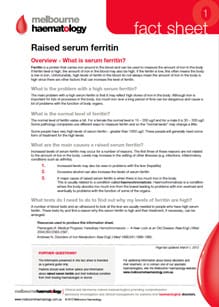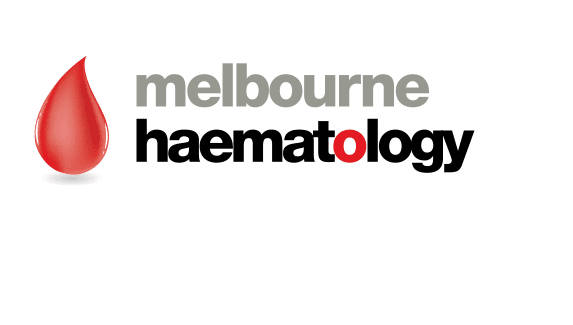Overview
An iron infusion is a minor procedure when an iron containing medicine is infused directly into the blood circulation. The iron containing preparation circulates and is delivered to the body organs that require iron for normal functioning.
Ferric carboxymaltose (FCM) also known as FERINJECT® is an intravenous (IV) iron preparation, a medicine that is used in the treatment of iron deficiency conditions such as iron-deficiency anaemia (IDA). It contains iron in the form of ferric carboxymaltose, an iron carbohydrate compound.
Iron is an essential element required for the oxygen-carrying capacity of haemoglobin in red blood cells and of myoglobin in muscle tissue. Moreover, iron plays an important role in many other vital processes in the human body.
In particular, Ferric carboxymaltose (FCM) is an iron preparation that has characteristics that allow larger single doses to be administered over a shorter infusion period compared with previously used IV iron preparations.
When is an iron infusion recommended?
Iron deficiency is a common cause of anaemia.
In Australia current clinical management recommends use of oral iron (in appropriate doses and for sufficient duration) as first-line therapy for most patients presenting with of iron-deficiency anaemia (IDA).
An iron infusion is sometimes recommended for people who are low in iron (iron deficient). Usually iron can be given orally but sometimes patients experience side-effects from oral iron (stomach upsets, constipation) or there are situations when oral iron is ineffective or cannot be used, and an iron infusion may be recommended.
If the body iron is particularly low, an iron infusion may be recommended to increase the iron stores quickly.
The aim of the iron infusion therapy is to replenish body iron stores and to remedy anaemia, a reduced level of haemoglobin due to iron deficiency.
Potential Risks &/or Side Effects
Are iron infusions safe?
It is generally recommended that iron therapy initially be given orally. Iron infusions are however considered safe particularly with the newer iron containing preparations currently available.
In the past (older) iron infusions were associated with common side-effects including allergic type reactions. This is much less common with the current iron containing preparation (Ferric carboxymaltose FCM also known as FERINJECT®) but this is still a potential risk. Your doctor will talk to you about the risks and the benefits of having an iron infusion in your particular circumstances.
What are the side-effects of an iron infusion with FCM?
It is unusual to experience any significant side-effects from an iron infusion with the newer iron containing medications.
Some patients may experience a headache or feel nauseated. Less commonly some patients experience flushing, a disturbance in taste, itchiness, fever and chills.
Please see the full list of side-effects of iron infusions (Ferinject) given to you by your doctor.
Iron Infusion Procedure
What do I need to do on the day of the iron infusion?
There is no particular preparation needed for the iron infusion.
It is helpful if you have had plenty of fluids to drink so finding a vein for the infusion can be easier.
You will be able to drive home after the iron infusion.
How long does the iron infusion take?
The infusion usually only takes 15 – 20 minutes once the IV drip infusion is commenced.
Is there anything I need to do after the iron infusion?

How common is Hereditary Spherocytosis (HS)?
HS is relatively common – around 1 person in every 5000 people has HS (around 800 people in Melbourne; population 4 million).
in 5000 people has HS
people in Melbourne
population of Melbourne*
What does having HS mean?
There are three main common problems associated with having HS:
There is another uncommon potential problem for people who have Hereditary Spherocytosis associated with a viral infection called “Slapped cheek”. Slapped cheek is caused by a virus called Parvovirus which can infect bone marrow cells and put the red cell producing cells “to sleep”. Because patients with HS need the bone marrow to be rapidly replacing the fragile red cells, this infection can cause a severe anaemia; patients can become very pale and sometimes even require blood transfusions. Fortunately this problem is uncommon.
Diagnosis
How is Hereditary Spherocytosis diagnosed?
HS is now diagnosed with a simple blood test. It is also important for a doctor to examine patients with HS to see if they are jaundiced or have an increase in the size of the spleen.
Treatment & Management
What do I need to do now that I (or my child) has been diagnosed with Hereditary Spherocytosis?
Most patients with HS do not need to do much about their condition at all. The bone marrow has the capacity to increase the number of red cells it produces many fold and is able to keep up replacing the fragile cells.
A few things may be helpful:
Will I (or my child) need a splenectomy?
Removing the spleen (splenectomy) has been used a lot in the past in the treatment and management of patients with HS; it stops the red cells from breaking down and solves the problems of HS.
Removing the spleen has problems however – the spleen is an important organ in the immune system and patients who do not have a spleen may be prone to getting serious infections. This risk is higher in younger children but may be less than previously expected because of newer vaccinations. It is now generally recommended to avoid splenectomy in children younger than 6 years and to ensure that children who may need a splenectomy have all the appropriate vaccinations.
Another approach for some of these young patients is to remove only a small part of the spleen – partial splenectomy. This is done in a few hospitals and there is some experience to say this may be very helpful for some patients.
Resources used to produce this information sheet.
- https://www.mja.com.au/journal/2010/193/9/diagnosis-and-management-iron-deficiency-anaemia-clinical-update
- http://www.nps.org.au/medicines/hormonal-and-metabolic-system/red-blood-cell-production-medicines/ferriccarboxymaltose/
ferinject-solution-for-injection - http://www.nps.org.au/publications/health-professional/nps-radar/2014/august-2014/ferric-carboxymaltose
Further Questions?
The information presented in this fact sheet is intended as a general guide only.
Patients should seek further advice and information about an Iron Infusion with ferric carboxymaltose (FCM) and their individual condition from their treating haematologist or doctor.



